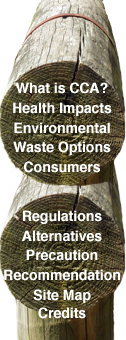Environmental Impacts
Introduction
![]() Leaching
residues
Leaching
residues
![]() Cradle
to Grave
Cradle
to Grave
![]() Preservative
Treatment Plants
Preservative
Treatment Plants
![]() References
References
Because CCA leaches out of the treated timber over time there can be residues of arsenic, copper and chromium on the surfaces of the wood and it can be washed off by rain to accumulate in the soil or water below. All three metals pose a potential threat to the environment. According to the US EPA: ‘The amount and rate at which arsenic leaches, however, varies considerably depending on numerous factors, such as local climate, acidity of rain and soil, age of the wood product, and how much CCA was applied.’ (Office of Pesticide Programs 2002)
Environmental contamination from CCA-treated timber can occur at many points along the life cycle of the product, from manufacture, to handling and use, and to disposal. The APVMA concluded that there are ‘unintended harmful environmental effects… [such as] contamination during the treatment process, leaching of arsenic from treated timber into soils or water, and disposal or burning of discarded timber’ (APVMA, 2003, p.9).
The environmental impacts of heavy metal leaching into surrounding soil and water, and dioxins and furans being released into the air when treated timber is burned, particularly after bushfires, have been the subject of a number of academic studies (see section on Waste Options).
The treatment plants can also get particularly contaminated. An audit undertaken by the NSW EPA of five timber treatment plants found contamination through inadequate storage of materials and wastes at 5 plants, failure to maintain drains, dams or treatment facility at 4 plants, and inadequate surface water controls at 4 plants (NSW EPA, 2003). There have been no corresponding audits of Victorian timber treatment plants by the Victorian EPA.
The Scientific Committee on Toxicity, Ecotoxicity and the Environment (CSTEE) of the European Commission noted: ‘There is extensive documentation of past substantial soil and groundwater contamination at wood treatment sites…There is also evidence in the published literature… that contamination of the soil and vegetation can extend to the area beyond the immediate boundaries of such sites, something that has been attributed to wind erosion, percolation, surface drainage as well as on-site incineration of wood waste’ (CSTEE, 1998).
APVMA (2003), The Reconsideration Of Registrations Of Arsenic Timber Treatment Products (CCA And Arsenic Trioxide) And Their Associated Labels (Review Summary), Australian Pesticides And Veterinary Medicines Authority, Canberra. (pdf - 1.2MB)
CSTEE (Scientific Committee on Toxicity, Ecotoxicity and the Environment) (1998), ‘Opinion on the Report by WS Atkins International Ltd (Vol. B) "Assessment of the Risks to Health and to the Environment of Arsenic in Wood Preservatives and of the Effects of Further Restrictions on Its Marketing and Use" Expressed at the 5th CSTEE Plenary Meeting.’ Brussels: European Commission (EC). 15 September.
NSW EPA (2003), Environmental Compliance Report- Wood Preservation Industry: Part A, Compliance Audit, NSW Environment Protection Authority, June.
Office of Pesticide Programs (2002). ‘Questions & Answers: What You Need to Know About Wood Pressure Treated with Chromated Copper Arsenate (CCA).’ US Environmental Protection Agency (EPA). 12 February. http://www.epa.gov/oppad001/reregistration/cca/cca_qa.htm.


